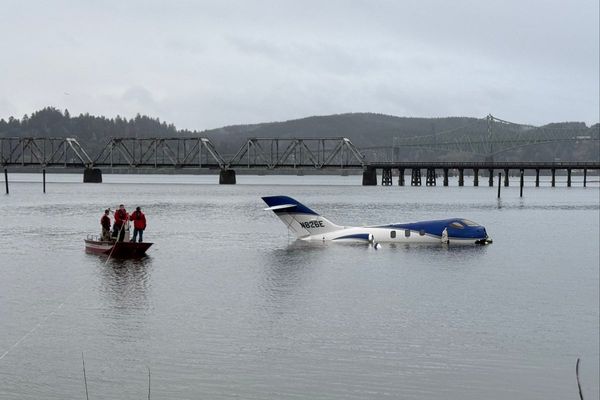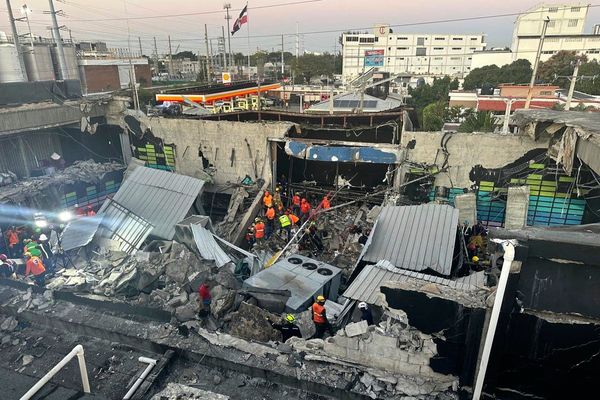The bad weather held off for the Biennale of Sydney's opening weekend, but it was a close call — and the irony of the situation was not lost on Colombian artistic director José Roca: this Biennale is dedicated to nature and water-based ecologies.
At the rain-drenched media call on Tuesday, Roca noted: "We are hearing the voice of nature right now."
Titled "rīvus" after the Latin for "stream" but also "rivalry", this Biennale offers work of astounding beauty while navigating troubled waters.
Works tackle pollution, climate change, and the effect of colonisation on First Peoples' custodianship of ecosystems.
Eight of the participants in the Biennale are rivers (including the Vilcabamba and Napo rivers in Ecuador; and the Baaka/Darling river in Australia), in acknowledgement of the global movement to recognise the rights of nature.
At Pier 2/3 in Walsh Bay, The Embassy of the North Sea, a group advocating for the legal personhood of that body of water (which lies off the east coast of England), has set up a temporary outpost as part of the Biennale.
Art and activism go hand in hand across the festival.
At the Art Gallery of New South Wales (AGNSW), Uncle Badger Bates, a Barkindji elder, artist and water advocate, presented a series of striking linocut prints and wall-mounted sculptures against a mural backdrop.
He said his key reason for being part of the Biennale was to speak about his Country and raise awareness of the ecological issues arising from government management of the Murray-Darling Basin river system.
At Pier 2/3, an installation of totem poles sits side by side with campaign posters by a group called Torres Strait 8: eight Traditional Owners from Zenadh Kes (Torres Strait Islands) who lodged a landmark class action against the Australian government for its inaction over climate change.
'A delta of possibilities'
Roca knew he wanted to pursue a theme of water when he was appointed in 2020, but also engaged a team of curators to collaboratively shape the Biennale with him — and says he had to remain open to their ideas and perspectives.
"I didn't want to impose that [my original theme] on my co-curators," he explains.
"If you're curating by yourself, you will bring a certain taste, a certain set of interests; that is unavoidable. When you curate collectively, then then all these other sensibilities come [into the mix]."
Working with that team, Roca's initial concept, or "source", branched out into "a delta of possibilities" over two years of conversation and collaboration.
"It is not a Biennale about rivers, or water for that matter; it's a Biennale about bodies of water and the ecologies they sustain, and it branches out into ideas of the rights of nature and voice of nature … inter species collaboration, the voice of the non-human, and many more [ideas]," Roca said at Tuesday's media call.
A line-up of more than 330 works and 80 participants is spread over six main locations, each with a different thematic focus.
This Biennale is smaller in scale than recent ones, by design: Roca was adamant from the get-go that he wanted to model a more sustainable kind of arts festival.
This has entailed minimal travel for him and his co-curators (Roca moved from Colombia to Sydney after being appointed and has not travelled internationally since), reduced freight, and different approaches to constructing the artworks and exhibition infrastructure.
In The Cutaway at Barangaroo, the Biennale's installation team created scaffolding to mount artworks on — but only clad the side holding the work: "The rest is left visible, so that we didn't spend material concealing anything from the people's view," Roca explains.
For cladding, they repurposed plywood hoardings from AGNSW's Sydney Modern Project.
The Biennale also conducted a public call-out for sustainable design innovations, and adopted several of the submissions — including a sustainable and non-toxic alternative to MDF (medium-density fibreboard).
"The truth is, unless these things are more systemic and ingrained in the way institutions work, it will only function on a symbolic level," says Roca.
Symbolic and tangible action are not always mutually exclusive, however: at AGNSW, the interactive work One Beat, One Tree (by the late Belgian artist Naziha Mestaoui) invites audiences to plant a virtual tree and nurture it using their body movement. For every virtual seedling, a real one will be planted.
The voices of nature
The voice of nature is present across the Biennale.
In The Cutaway, field recordings of Australian water birds emanate from a hanging installation of branches shaped like the Murray river basin, created by Mexican artist Tania Candiani.
A few levels up, in a temporary gallery space created on Stargazer Lawn, visitors can listen to the sounds of more than 1,500 creatures from around the world — including the blue-headed parrot and the Great Potoo of the Amazon; the California sea lion and the Humpback whale — in The Great Animal Orchestra.
The work is the offshoot of a decades-long project by American musician and sound designer Bernie Krause, who worked with UK collective United Visual Artists to turn his library of recordings into an audio-visual installation.
Down the road at Pier 2/3, visitors can listen to underwater field recordings capturing the biodiversity of the North Sea, made by the Embassy of the North Sea.
Nature is given a more poetic voice, too: for each of the rivers 'participating' in the Biennale, a video has been made in which a cultural custodian imagines what the river would say.
A number of the artworks are living, growing entities: a series of 'photographic' portraits on vertical beds of grass, by UK duo Ackroyd & Harvey; and fabric works made from grass roots, by German artist Diana Scherer.
Several artworks also function as visual records of endangered biodiversity: at AGNSW, a series of drawings by Sheroanawe Hakihiiwe, an Indigenous Yanomami artist from the Venezuelan Amazon region, depicts plant life; at the Museum of Contemporary Art (MCA), illustrations by Nonuya-Muinane artist Mogaje Guihu (aka Abel Rodríguez) capture the many species of pineapples and yuccas, among other native flora.
Roca's connection to nature started in childhood; while he grew up in Bogota ("It doesn't get more non-rural than that," he says dryly) his father was in charge of a nature park in the Caribbean: "I was like a wild kid, just roaming around alone in that park," he recalls.
Later in life, that connection to nature played out in hikes and camping. His perspective has also been shaped by Indigenous rituals involving Yagé (or Ayahuasca), which are premised on the interconnectedness of the natural world.
It perhaps accounts for the sense that his Biennale exhibits not just a tangible and philosophical connection to nature but also at times a spiritual one.
The Biennale of Sydney runs until June 13, 2022.







